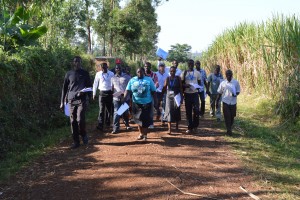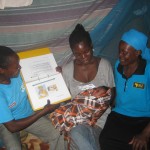#AddYourCount Series: Lwala Community Alliance

The next interview in our #AddYourCount Series is with Mercy Owuor, the Community Programs Director of Lwala Community Alliance in Kenya. Lwala’s goal is to “build the capacity of the people of Lwala, Kenya, to advance their own comprehensive well-being.”
What are some of the services provided by your current CHW program?
Lwala Community Alliance community health workers (CHWs) feed into distance surveillance systems by collecting monthly data, which is analyzed and used for decision making. They are the first line of defense in detecting and attacking disease including diarrhea, measles, and other outbreaks, where it matters most – households. Our CHWs play a key role in disease prevention by providing health education at the household and community level for immunizations, reproductive health, water sanitation and hygiene among others. Our CHWs also provide referrals, community mapping services and WASH promotion, contraceptive services, and conduct household follow-ups with the use of mobile phones to remind clients to comply with treatment including scheduled visits like antenatal (ANC) and postnatal care (PNC).
CHWs also provide support services at the hospital especially in the maternity ward. Thirty percent of our CHWs were former traditional birth attendants and because of the trust they have developed with pregnant mothers, they play the role of providing moral support to the women when they come to the hospital to deliver. Due to their standing and role in the community, our CHWs mobilize the community into action. They are the gatekeepers and this gives them a level of trust allowing them to mobilize the community to increase latrine coverage and reduce diarrhea and cholera-related disease among other health related issues.
How do demographic and social issues within communities inform and affect the decisions you make with your CHW program?
Low literacy levels affect the quality of programs. There are also issues surrounding gender, with CHWs sometimes shying away from specific roles, and the lack of male involvement can only be tackled when the majority of men agree to participate in community health as CHWs. We must also figure out how to capitalize without eliminating existing community systems, like the traditional birth attendants, to improve on maternal, neonatal, and child health outcomes by putting them in the driver’s seat to create demand for skilled delivery rather than working against them.
What are some challenges that you see to scaling up CHW programs?
- Varied skill levels: Community members who cannot read and write are selected to become CHWs and expected to submit data or reports on a monthly basis.
- Incentive models vs. volunteerism: CHWs have personal and family needs and if appropriate incentives are not offered then CHWs will not be motivated to work.
- Unclear service delivery expectations: CHWs are used by different organizations to meet their own objectives and then are left guessing who will engage them next once a program ends. This impacts retention as CHWs seek other opportunities that are more promising and secure.
- Lack of standard data collection tools: In many cases, data collection is not aligned with government requirements.
- Lack of government commitment to create standard operating procedures: As CHWs are a contributor in the health care system, it is important for them to have clear standards and protocol.
- Lack of technology: Technology used to harmonize CHWs programs is critical as a majority of CHWs still carry numerous papers to collect data and report to the Ministry of Health and partners.
- Lack of supervision: Lack of feedback on CHW performance contributes to CHWs feeling like they are not contributing to the control and reduction of diseases in their communities.
How is your organization working to optimize CHWs’ impact through technology?
We are currently working on a community mapping exercise. We’d like to crowd-source this task to volunteers who would use Open Street Map to map the 3,000 houses, roads, and buildings in our catchment. Once the mapping is complete, we plan to use CHWs and community youth to put meaning behind the map as we’ll need to add context on the ground in Kenya. For example, providing critical information on where under 5 children live, where water sources have improved, which areas are open defecation free (ODF), and which roads are not passable by vehicle.
Once collected, we will integrate public health data collected by CHWs into the map. We would like to team up with our friends at Vera Solutions to create a suitable information management system and link this data to households that have been mapped. Then we can share the mapped data with the CHWs at monthly meetings. We believe that by seeing their own data on a map, CHWs will better understand the links between the environment, health-related behaviors, and child wellness. More importantly, they will be able to effectively communicate those relationships to community members they visit. We are hoping to innovate and evolve what we map and how we share it, focusing on solutions that are most beneficial, such as mapping households associated with an outbreak, like typhoid, to help identify the source of the epidemic.
What are some current goals that you are working on reaching at the Health Center?
We want to deliver holistic programs that create impactful change in people’s lives. There are 3,800 households in North Kamagambo, Kenya and we hope to motivate all of them to be actively engaged in the pursuit of their own health goal. This would hopefully reduce preventable sickness and early death for the 20,000 people living there.
Another goal is measuring improvements in the lives of our beneficiaries to ensure quality and impact. This involves strengthening ongoing monitoring of individual program data and cross-section indictors of impact, developing a culture of data usage at all levels, instituting a continuous quality improvement process for key programs within two years, utilizing cost benefit measurements, and strengthening the staff capacity in monitoring and evaluating.
We also want to demonstrate that quality community development can be achieved in a rural setting and share practical insights for the advancement of global development. This can be done by inviting collaboration and co-learning from funders, non-profit peers, the Kenya government, and research institutions, communicating the legitimacy of the locally driven, holistic programs in the larger development contact, and publishing our results.
How is Lwala Community Alliance preparing for post-2015 and the achievement of the SDGs?
We believe that meaningful development can be achieved through a multi-dimensional approach. Lwala has outlined a 2020 strategy that will lead to achieving the SDGs, and the first goal is to deliver holistic programs that will create impactful change in people’s lives.
Regarding health, we aim to promote physical health through the provision of wellness, preventative and medical care. When we see a reduction in preventable sickness among 20,000 people living in North Kamagambo, Kenya, we will know that we are achieving the SDG on universal and equitable access to quality healthcare.
—
If you would like to learn more about Lwala Community Alliance and their amazing work please visit their http://lwalacommunityalliance.org/ and follow them on Facebook and twitter (@LwalaCommunity). Be sure to check back next week for the next interview of the #AddYourCount blog post series!

